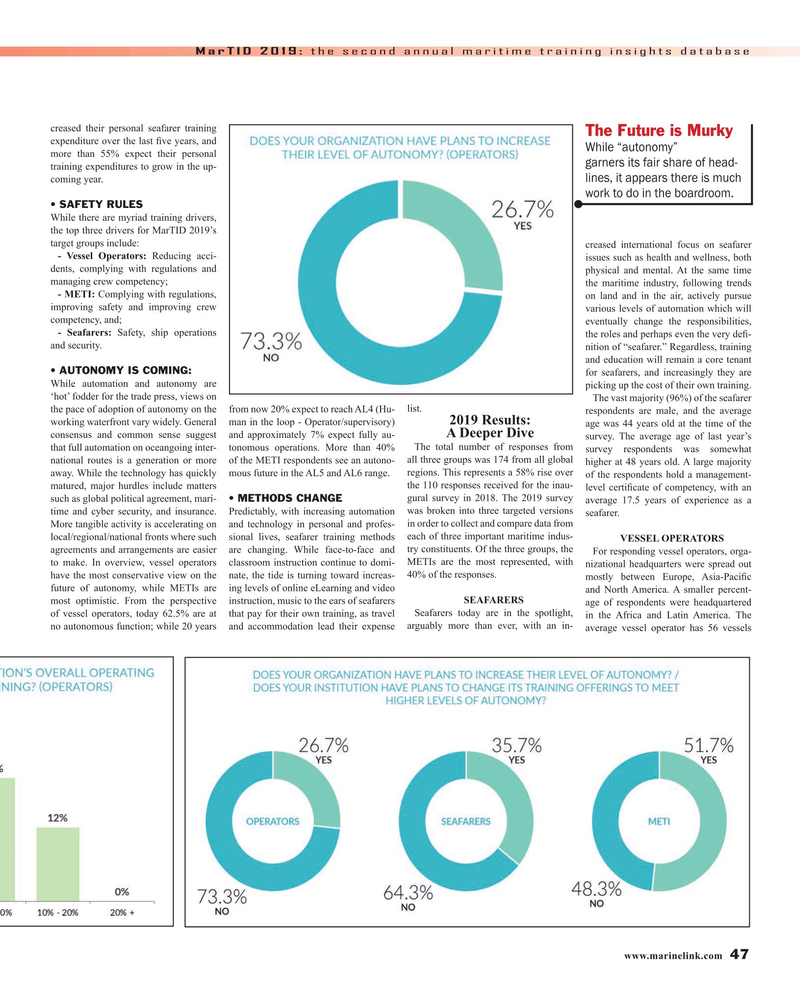
Page 47: of Maritime Reporter Magazine (June 2019)
80th Anniversary World Yearbook
Read this page in Pdf, Flash or Html5 edition of June 2019 Maritime Reporter Magazine
MarTID 2019: the second annual maritime training insights database creased their personal seafarer training
The Future is Murky expenditure over the last ? ve years, and
While “autonomy” more than 55% expect their personal garners its fair share of head- training expenditures to grow in the up- lines, it appears there is much coming year.
work to do in the boardroom.
• SAFETY RULES
While there are myriad training drivers, the top three drivers for MarTID 2019’s target groups include: creased international focus on seafarer - Vessel Operators: Reducing acci- issues such as health and wellness, both dents, complying with regulations and physical and mental. At the same time managing crew competency; the maritime industry, following trends - METI: Complying with regulations, on land and in the air, actively pursue improving safety and improving crew various levels of automation which will competency, and; eventually change the responsibilities, - Seafarers: Safety, ship operations the roles and perhaps even the very de? - and security.
nition of “seafarer.” Regardless, training and education will remain a core tenant • AUTONOMY IS COMING: for seafarers, and increasingly they are
While automation and autonomy are picking up the cost of their own training. ‘hot’ fodder for the trade press, views on
The vast majority (96%) of the seafarer the pace of adoption of autonomy on the from now 20% expect to reach AL4 (Hu- list.
respondents are male, and the average 2019 Results: working waterfront vary widely. General man in the loop - Operator/supervisory) age was 44 years old at the time of the
A Deeper Dive consensus and common sense suggest and approximately 7% expect fully au- survey. The average age of last year’s
The total number of responses from survey respondents was somewhat that full automation on oceangoing inter- tonomous operations. More than 40% all three groups was 174 from all global higher at 48 years old. A large majority national routes is a generation or more of the METI respondents see an autono- regions. This represents a 58% rise over of the respondents hold a management- away. While the technology has quickly mous future in the AL5 and AL6 range.
matured, major hurdles include matters the 110 responses received for the inau- level certi? cate of competency, with an gural survey in 2018. The 2019 survey average 17.5 years of experience as a such as global political agreement, mari- • METHODS CHANGE time and cyber security, and insurance. Predictably, with increasing automation was broken into three targeted versions seafarer.
More tangible activity is accelerating on and technology in personal and profes- in order to collect and compare data from local/regional/national fronts where such sional lives, seafarer training methods each of three important maritime indus-
VESSEL OPERATORS agreements and arrangements are easier are changing. While face-to-face and try constituents. Of the three groups, the
For responding vessel operators, orga-
METIs are the most represented, with nizational headquarters were spread out to make. In overview, vessel operators classroom instruction continue to domi- have the most conservative view on the nate, the tide is turning toward increas- 40% of the responses.
mostly between Europe, Asia-Paci? c future of autonomy, while METIs are ing levels of online eLearning and video and North America. A smaller percent- most optimistic. From the perspective instruction, music to the ears of seafarers SEAFARERS age of respondents were headquartered
Seafarers today are in the spotlight, in the Africa and Latin America. The of vessel operators, today 62.5% are at that pay for their own training, as travel no autonomous function; while 20 years and accommodation lead their expense arguably more than ever, with an in- average vessel operator has 56 vessels www.marinelink.com 47
MR #6 (42-49).indd 47 6/4/2019 8:53:01 AM

 46
46

 48
48
